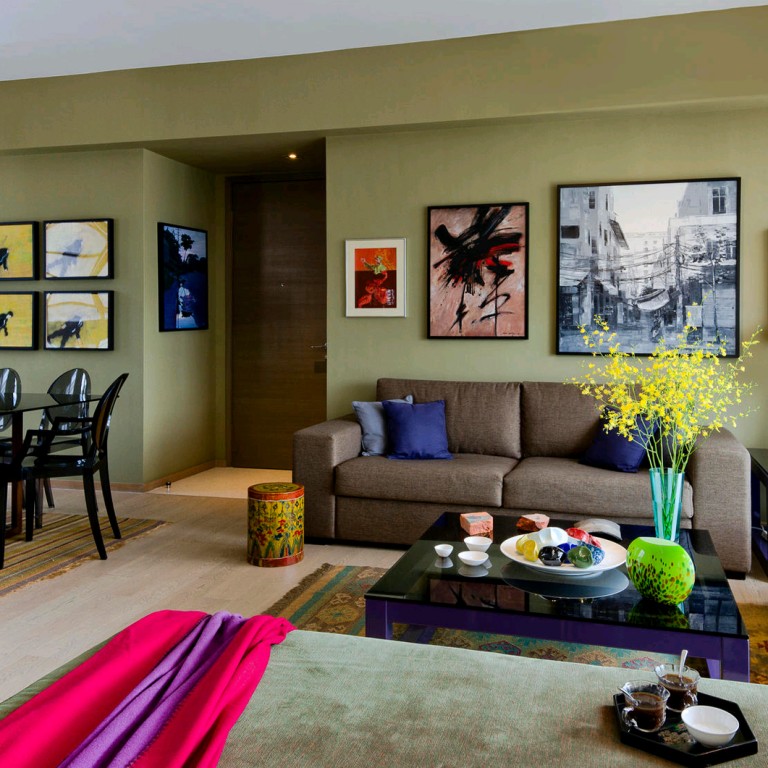
Green with envy: unusual colour used to transform art-filled Hong Kong flat into spacious home
Green sets the tone for a couple's warm, art-filled Sai Ying Pun apartment, writes Charmaine Chan.

Few in Hong Kong have the nerve to paint their home interior a deep celadon hue. But Richard Blight had no difficulty persuading two expatriate art lovers of its charms.
Displaying the colour beside earthy seagrass wallpaper, rich cinnabar red and Jim Thompson silk upholstery to match the walls, he was immediately given the green light, literally, to transform a nondescript new apartment in Sai Ying Pun into a warm, distinctive pad.
Blight was also tasked with adapting the layout to suit the lifestyle of his clients: James, who is from Australia, and Luisa Kay, an Italian writer of children's books on art.
Kay doesn't mince words when describing the 900 sq ft apartment they bought last year.
"The good thing was the view," she says. "But it was a stupid apartment with stupid rooms. You couldn't even put a bed in them."
To give them a sense of space (they like to entertain), two of three contiguous bedrooms were eliminated: one became part of the living area; the other was turned into a large dressing room complete with a bay-window seat.
All were decked out in celadon, because, Blight says, "If you use one colour it makes the apartment look bigger. If you use different colours you don't have that connection."
Mirrored panels on either side of a classic-Chinese-red entertainment unit also heighten the sense of space, in part because they reflect views of the harbour.
"The mirror gives depth," says Blight. "It makes the room disappear into another and it doubles the space."
Credit for one of the apartment's best features, however, must go to Kay. During the renovation she realised the kitchen could be opened to the living area by carving a bar out of a former helper's room that had been wedged between the two.
"It works well," says Kay. "You can put finger food on it, and use it as a desk when you want to stand up and work. After a while sitting is boring."
Without a dedicated study, Kay also works from the generously sized Chinese bed in the middle of the living room. That piece of furniture, constructed by tongue and groove, is also something to lounge on while watching television, and a convivial spot for guests.
"When I have a dinner party people sit all over it," says Kay. "It's nice because you can sit on one side and chat to people on the other side."
From this central area you can scan the art that fills the flat. Some pieces - including paintings on brick fragments salvaged from demolished hutongs in Beijing - were acquired from Schoeni Art Gallery, in Central, where Kay met Blight, who was behind the gallery's final renovation before it temporarily closed in 2013.
Many of the artworks she and her husband kept for the apartment (bigger pieces were shipped to their other homes, in Australia and Italy) have an Asian connection, which complements the contemporary Chinese style.
Did the pair ever have jitters?
"We had a moment when we thought maybe the tone should be a little lighter, but Richard said, 'You have to be braver and try it,'" says Kay.
Any doubt has since vanished.
"A dark colour is good for a small place and there's a lot of light in here," she says. "In the evening it's really cosy."
Kitchen Though the elm screen doors (HK$12,000), made by Concord Arts & Crafts, is the kitchen that came with the apartment. The still-life, by Liang Yifeng, and work from Cheng Tsai-tung’s Elusive series were both bought through Christie’s.
Dining area Four gouache works, by Wu Yiming, bought through Sotheby’s, and a work by Way, acquired through Christie’s, flanks a standing Buddha from Myanmar that came from Arch Angel Art (53 Hollywood Road, Central, tel: 2851 6882). The dining table, designed by Kay, was made by Lux Home for HK$25,000, and the Kartell chairs (HK$1,640 each) came from Aluminium. The green Venetian vases were found at Milan’s Navigli market. The pendant lampshade came from an old standing lamp.
Bar The lamp (HK$5,200) came from Lane Crawford Home Store. The sculpture, titled Red Book, by Liu Kun, came from Yan Gallery (Chinachem Hollywood Centre, 1 Hollywood Road, Central, tel: 2139 2345). The works on the wall, by Chinese-French artist Sanyu, were bought through Christie’s.
Bedroom The bedside tables (HK$3,000 each) were made by RCC (Contracting). The seagrass wallpaper (HK$570 per 5.5-metre roll) came from Altfield Interiors. Two of Kay’s favourite artworks are the red and gold shoes, by Peng Wei, from Plum Blossoms Gallery. On the bedside table, the 19th-century blanc de Chine figure of Tu Di Gong, came from Arch Angel Art. The basket was a wedding present and the jewellery box came from a market in Wan Chai.
Dressing room The dressing room, accessed from the sole bedroom, features a bay window seat and a cabinet (HK$14,000) made by RCC (Contracting). The artwork came from Cat Street.
TRIED + TESTED
A floor-to-ceiling plywood panel, covered in seagrass wallpaper from Altfield Interiors, was installed against the windows to give a focal point to the dining table. The panel affords privacy and provides another surface on which to hang art. Luisa Kay uses the small balcony for pots of herbs and as a display area for her collection of Mao Zedong statuettes.

